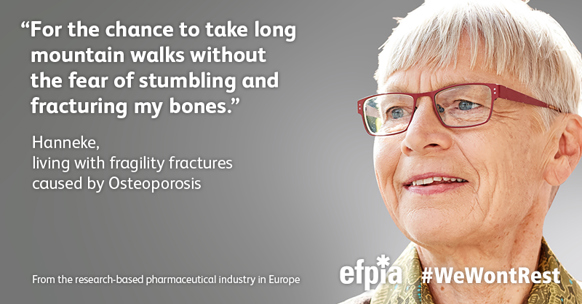#ForTheChance to take long mountain walks without the fear of stumbling and fracturing my bones (Guest blog)
19.10.18

I am Hanneke from the Netherlands, and I have experienced fragility fractures caused by Osteoporosis. Although one in three women and one in five men over 50 will experience a fragility fracture in their remaining lifetime[1], fragility fractures do not get much attention. Public opinion, physicians, and often patients themselves consider it as an inevitable symptom of ageing rather than the result of weakened bones.
Osteoporosis is a disease that weakens the bones, thus increasing the risk of fracture. The loss of bone is silent and progressive, until the first fragility fracture occurs from casual activities such a “minor fall, picking up a bag of groceries, and in more serious cases, from a simple action such as a sneeze[2]”. In my case, I fractured my upper arm by hitting the kitchen’s door knob.
As I blamed it on age and clumsiness, neither I or my doctor realize that this first fracture was a warning sign: a fracture increases the risk of a subsequent fracture. Only 6 years later I was diagnosed with celiac disease and, consequently with osteoporosis. It took another year before I received the right information about the disease. Despite my background in healthcare, I felt helpless and apprehensive: what could I do to prevent another fracture from happening?
While osteoporosis is a silent threat, fragility fractures are very painful. Few people realize that they can lead to deformities[3] (vertebral fractures), loss of function (wrist/ ankle fractures), disability and even death (hip fractures). Beyond the recovery, fragility fractures can greatly affect your wellbeing, your independence, and your ability to carry out daily tasks. Last but not least, fragility fractures not only affect people physically but also emotionally. Because they fear of falling, most patients limit their social and physical activities.
With the celebration of World Osteoporosis Day on October 20th, there is an opportunity to reflect on the impact of the disease on patients, and how to mitigate it. My wish for all patients with/ at risk of fragility fractures is that osteoporosis is taken seriously, especially after a first fracture. As our societies are ageing, we all want to grow old gracefully. By taking good care of our bones, which is possible with lifestyle adjustments and medication, we can keep on doing what makes us happy, e.g. walking, cycling, swimming, engaging in social activities, playing with our grandchildren. As far as I am concerned, I am still hopeful that I will be able to take long mountain walks again, without the fear of stumbling and fracturing my bones.
[1] World Osteoporosis Day. About OSteoporosis. Availbale at: http://worldosteoporosisday.org/about-osteoporosis
[2] NOF. What is osteoporosis? Available at: https://www.nof.org/patients/what-is-osteoporosis/ osteopedia-2/.
[3] IOF. Facts and statistics. Available at https://www.iofbonehealth.org/facts-statistics#category-14.